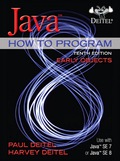
Concept explainers
Fill in the blanks in each of the following statements:
Typically, statements are used for counter-controlled
iteration and statements for sentinel-controlled iteration.
The “for loop” statements are used for counter-controlled iteration and “while loop” statements used for sentinel-controlled iteration.
Explanation of Solution
“for” loop:
- The for loop gets starts with the keyword “for”. It contains three control structures and these control structures are separated using (;) semicolon. They are:
- “Initial-action”, used to initialize the control variable.
- “Loop-continuation-condition”, it determines whether the loop gets repeated.
- “Action-after-each-iteration”, used to update the control variable for next iteration.
- So, the “for” loop always used for counter-controlled iteration.
A for loop is used to execute a block of statements repeatedly until the condition is true. The syntax of for loop:
for(i=initial_value;i<end_value;i++)
{
Loop statements;
}
- Here, the variable “i” is referred as control variable, it controls how many times that the loop gets executed.
“while” loop:
The “while” loop first checks its expression and then the statements inside the loop are executed. It is also called as pretest loops.
- These loops do not have to be terminated with a semicolon.
- With the false expressions, the loops can be terminated.
- So, the “while” loop always used for sentinel-controlled iteration.
Syntax:
The syntax for the while loop is as follows:
//while loop statement
while (condition)
{
//statement
}
Want to see more full solutions like this?
Chapter 5 Solutions
Java How To Program (Early Objects)
 C++ Programming: From Problem Analysis to Program...Computer ScienceISBN:9781337102087Author:D. S. MalikPublisher:Cengage Learning
C++ Programming: From Problem Analysis to Program...Computer ScienceISBN:9781337102087Author:D. S. MalikPublisher:Cengage Learning Microsoft Visual C#Computer ScienceISBN:9781337102100Author:Joyce, Farrell.Publisher:Cengage Learning,
Microsoft Visual C#Computer ScienceISBN:9781337102100Author:Joyce, Farrell.Publisher:Cengage Learning, C++ for Engineers and ScientistsComputer ScienceISBN:9781133187844Author:Bronson, Gary J.Publisher:Course Technology Ptr
C++ for Engineers and ScientistsComputer ScienceISBN:9781133187844Author:Bronson, Gary J.Publisher:Course Technology Ptr- Np Ms Office 365/Excel 2016 I NtermedComputer ScienceISBN:9781337508841Author:CareyPublisher:Cengage
 EBK JAVA PROGRAMMINGComputer ScienceISBN:9781337671385Author:FARRELLPublisher:CENGAGE LEARNING - CONSIGNMENT
EBK JAVA PROGRAMMINGComputer ScienceISBN:9781337671385Author:FARRELLPublisher:CENGAGE LEARNING - CONSIGNMENT Programming with Microsoft Visual Basic 2017Computer ScienceISBN:9781337102124Author:Diane ZakPublisher:Cengage Learning
Programming with Microsoft Visual Basic 2017Computer ScienceISBN:9781337102124Author:Diane ZakPublisher:Cengage Learning





